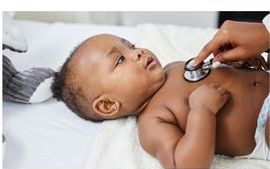- Published:
- 20 January 2025
- Author:
- Sharif Ismail and Julie Yates
- Read time:
- 12 Mins
Vaccination is one of the most effective public health interventions available, yet coverage across many of the routine childhood programmes across the UK has been steadily declining. In this article, Sharif Ismail and Julie Yates from the UK Health Security Agency discuss some of the long-term challenges for vaccine preventable disease prevention and control in England and review key recent and upcoming changes to the routine schedule for children and young people.
Globally, vaccination is the most effective public health infectious diseases intervention, ranking second only to clean water for disease prevention. One hundred years ago, the biggest threat to life in people under the age of 35 was infection; it is now external factors. The economic benefits of vaccination are substantial. They can be found both in direct savings to the NHS1 and sizeable, wider returns on investment when compared with most other classes of public health intervention in terms of educational attainment, economic productivity and other outcomes.2
In this article, we provide an update on key recent and impending changes to national vaccination programmes for children and young people and an overview of ongoing work with partners across the immunisation system in England, to bolster uptake and to reduce inequities in outcomes from vaccine-preventable disease (VPD).
The challenge of steadily declining uptake of childhood vaccination
Although vaccination uptake through routine programmes in England is high by international standards, there has been a progressive decline in coverage of all vaccines (mirrored across the other devolved administrations) each year since 2013.3 The cumulative effect of this is now significant.
There are many reasons for this decline. We know from wider research evidence that there are important variations in uptake between and across populations although the causes for this vary by geography, ability to access services, deprivation and many other factors. Observed declines have unfortunately also been accelerated by disruption during the pandemic. In addition, the service delivery landscape for immunisation has seen significant organisational change, most significantly in 2013, but most recently in preparation for delegation of commissioning responsibilities for vaccination to Integrated Care Boards by April 2026.
Encouragingly, though, the UK Health Security Agency’s (UKHSA) attitudinal survey work continues to show high levels of confidence in both vaccination and those who deliver vaccines among both parents and young people.4,5 This underscores the importance of ensuring best access to vaccination for children and young people and of health professional advocacy, given that the NHS remains the most trusted source of information on vaccines.
Long-term effects of the COVID-19 pandemic
The long-term impacts of returning to regular patterns of social mixing following the pandemic, changes in population-level immunity resulting from COVID-19 related restrictions and disruptions to delivery of routine immunisation throughout 2020–21 continue to influence the picture for VPDs in England. In 2023–24, we have seen 2 substantial outbreaks of VPDs with established vaccination programmes, both linked in part to long-term pandemic effects and declines in vaccine uptake.
There was a rapid increase in measles cases in late 2023 driven by a large outbreak in Birmingham, with subsequent increase in London and small clusters in other regions.6 Case counts have followed a downward trajectory since mid-July 2024 but small, localised outbreaks continue. Most cases have occurred in unvaccinated children under 10 years old. UKHSA continue to raise awareness of measles and the importance of vaccination, targeting vaccination activity in areas at risk of outbreaks, and there is evidence of positive impacts from work across the health system to improve measles, mumps and rubella (MMR) vaccination uptake in this context.7
Similarly, from late 2023 onwards, a surge in laboratory-confirmed pertussis cases was observed nationwide.8 Although case numbers have now considerably reduced, pertussis activity remains high by historical standards. The current outbreak is the largest seen since 2012 and tragically included 10 infant deaths in 2024. Much of the work of UKHSA and partners in recent months has focused on bolstering uptake through the maternal pertussis vaccination programme to ensure the best protection is offered to the youngest infants who are most vulnerable to severe outcomes from infection, but also too young to have developed protection of their own through childhood immunisation. In common with the childhood programmes, uptake of this programme had been steadily declining in recent years.9 Recent evidence on the effectiveness of maternal vaccination continues to show that it offers excellent protection against severe outcomes for infants.
The routine vaccination schedule for children and young people in the UK has changed dramatically since its inception.10 The pace of change has also increased since 2000, as the scope in terms of diseases able to be targeted has increased. In addition to new vaccines, the national programme undergoes clinically significant changes at least once a year (for example, changes in scheduled ages, increases in eligible populations or use of an updated or reprocured vaccine product).
Recent changes to the schedule
There have been important changes to the national schedule relevant to children and young people over the past year. For pregnant women, for example, a change was implemented from July 2024 to the vaccine product used in the prenatal pertussis vaccination programme11 to move to the Tdap vaccine ADACEL. This was in light of emerging evidence that maternal vaccination using inactivated polio-containing vaccines makes infant response to polio vaccination received as part of the routine schedule less effective.12 A wholly new programme for RSV vaccination in pregnancy,13 alongside a programme for those aged 75–79 years, has also been introduced for the first time from this autumn, in recognition of the burden of mortality and morbidity among the youngest and oldest caused by this virus. This programme has the potential to transform the picture for RSV prevention and control, with significant implications for children and young people’s wellbeing, and for health services, especially during the winter months.
For adolescents, the HPV vaccination14 schedule changed from September 2023, moving from the previously recommended 2 doses to a single-dose schedule, in light of evidence15 on both the effectiveness and duration of protection accruing from single-dose administration. This change will hopefully improve resilience in the national HPV vaccination programme by reducing the number of individual health service contacts required for eligible adolescents to complete their vaccination course, strengthening the impact of this highly effective vaccine.
Schedule changes in progress
Further changes are due for implementation over the coming 18 months. For example, a combined vaccine for Haemophilus influenzae type b/meningococcal C vaccine was introduced into the routine childhood immunisation programme in 2006, and the adolescent meningitis ACWY programme has shown remarkable success in controlling meningococcal C (MenC) disease across the population.
However, the discontinuation of Menitorix (Hib/MenC) vaccine production, currently given at 12 months of age, has also prompted new JCVI recommendations,16 including that a dose of MenC-containing vaccine is no longer advised at 12 months, and that an additional dose of Hib-containing multivalent vaccine should be given at 18 months. This latter change requires the creation of a new 18-month routine immunisation appointment, with the further JCVI recommendation that the second dose of MMR vaccine should be brought forwards from 3 years 4 months to 18 months of age to improve vaccination coverage. Work is currently underway to plan for these changes, including the use of hepatitis B containing vaccine (as the hexavalent DTaP/IPV/Hib/HepB) at the 18-month visit, which means that there will no longer be a need for babies of high-risk mothers to receive a monovalent Hep B vaccine at 12 months. A wide range of resources are being developed to support the implementation of these changes which are planned to come into effect in July 2025 and January 2026.
Ensuring the best immunisation outcomes for all children and young people is crucial to giving them the best opportunities to lead a healthy life, no matter where they live or who they are. Doing so depends on partners across the health system working together effectively across a whole range of areas, drawing on current best evidence: not just on vaccination delivery.17
Alongside many other activities, improving immunisation outcomes relies on:
- providing accurate and timely advice to parents and young people to inform decisions on vaccination uptake (including using UKHSA-developed resources18 for different patient groups, especially for groups most at-risk19)
- delivering the right vaccines to the right people, at the right time
- promptly identifying and acting on cases and outbreaks of notifiable, vaccine-preventable disease20
- optimising post-exposure prophylaxis for relevant VPDs
- gathering data to inform public health surveillance.
We recognise the vital contribution frontline clinicians make across all these areas and will continue to work with colleagues from RCPath and elsewhere emphasising the importance of timely and complete vaccination uptake across the routine programmes.
Addressing overall trends to declining vaccination coverage is a key, strategic priority for UKHSA and our partners in the NHS and other organisations, and a central driver for action under the NHS’ vaccination strategy.21 We also continue to work to reduce inequities in immunisation outcomes through implementation of our Inequalities Strategy22 – which is currently being updated. The updated strategy will emphasise the importance of ensuring the core national vaccination programmes are as strong as possible, because improving vaccination coverage overall helps protect everyone through herd protection and other mechanisms, and because we know that the positive impact of routine vaccination tends to be greater among the most vulnerable.23
This is an exciting and dynamic time for childhood immunisation programmes, with important, long-term challenges needing to be addressed to ensure appropriate protection for all children and young people. Close collaboration between clinicians, health services, community leaders and the public will be essential to maximising the benefits that all children and young people can gain from immunisation.
References available on our website.
Return to January 2025 Bulletin





